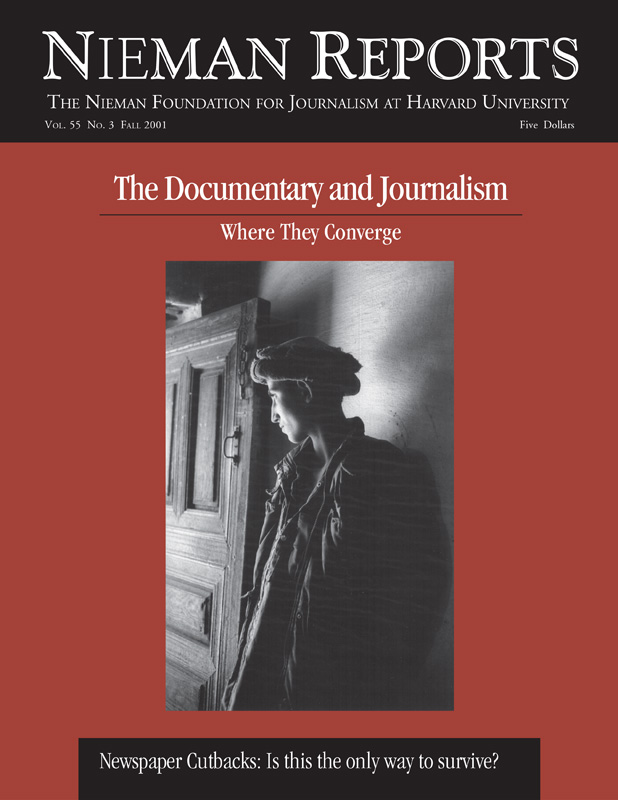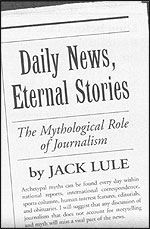

Daily News, Eternal Stories: The Mythological Role of Journalism
Jack Lule
The Guilford Press. 244 Pages. $17.95.
Jack Lule has written a very good and engaging book about journalism and myth, and because of all the things to admire—the clarity, originality, scholarship and becomMing intellectual modesty of the author—I put it down with a sense of foreboding. Even now, journalists somewhere must be enduring a PowerPoint presentation: “Myth: How to Write It and Why.”
In my imagination, I see a newsroom still aglow from the recent workshops to reconnect the paper with citizens (readers or the public, in a simpler time). A new sense of purpose suffuses the place. Received truth once more has asserted itself. Nonetheless, something is amiss. The editor frowns as he works over the Sunday take-out. The copy is clean enough to eat from. The facts are in order. But what is this? Try though he may, the editor cannot find the myth.
There is no Trickster, no Good Mother. He searches in vain for one of the great Master Myths—the Victim, the Hero, the Scapegoat, even the Flood, though this story happens to be about a fire in the projects. Finally, in exasperation, he summons the reporter in hopes of negotiating a rewrite.
Had this burlesque occurred, Jack Lule would be appalled. His book, “Daily News, Eternal Stories,” is not meant as a guide to newsroom practice. A former journalist and now chair of the Department of Journalism and Communication at Lehigh University, Lule offers an interesting way of looking at the news by demonstrating that the stories we put in the paper can be read as versions of our oldest myths.
Even so—and here my scalp begins to prickle—Lule asserts that “any attempt to address the crisis [in journalism] that does not recognize the mythological role of journalism is destined to fail.” The information model of journalism is bankrupt, he suggests. “Newspeople think they are in the information business…. But newspeople primarily are in the story business. And news will remain a subject of crisis as long as it strays from story.”
Myths, of courses, are the universal, eternal stories. But how are they also journalism? Like this, Lule suggests: “Myths,” he writes, “draw upon archetypal figures to offer exemplary models that represent shared values, confirm core beliefs, deny other beliefs, and help people engage with, appreciate, and understand the complex joys and sorrows of human life.” So, of course, do news stories, and in them, Lule says, we can hear “the siren song of myth.”
Seven case studies are provided from The New York Times, which Lule calls our State Scribe, “society’s privileged and preeminent storyteller.” Lule’s exhaustive work describes how the details and themes of hundreds of stories coalesce into myth. Here’s an example. In the coverage of the murder of Leon Klinghoffer, the elderly American tourist killed in 1985 by Palestinian terrorists, Lule found the recreation of a compelling myth, the sacrifice of the Victim.
The story begins with Klinghoffer, who was confined to a wheelchair, among the hostages aboard the cruise ship Achille Lauro. Then he is killed and the tale focuses on the widow’s agony. A more detailed portrait of the victim emerges, and he is transformed from a most ordinary man into a hero. (A headline: “Aged Victim, Portrayed as Helpless, is Recalled as a Strong, Happy Man.”) The president calls to offer sympathy and strength. The body is brought home, and the governor, the mayor and two U.S. senators are there. Klinghoffer has become “a symbol of righteousness in a world filled with evil and cruelty.”
We can now find meaning in seemingly senseless and random violence: The Victim’s life was sacrificed for others. “In the face of chaos,” Lule writes, “order is established. In the face of death, life is affirmed. In the face of tragedy, news becomes myth.”
By examining with similar meticu-lousness the degrading stories about the death of Huey Newton, a founder of the Black Panthers, Lule finds the myth of the Scapegoat and its warning to those who challenge social orthodoxy. Mark McGwire and his “quest” for the home run record recall the myth of the Hero from humble origins; Mother Teresa becomes the mythological Good Mother, “blessed among women;” the boxer and rapist Mike Tyson is seen as the Trickster, “the original savage/victim;” the coverage of Haiti evokes the myth of the strange and frightening Other World; a hurricane in Central America provides the myth of the Flood, the devastation set loose upon a people by elemental forces beyond their control and because of their iniquity (in this case the corrupt government and corporate policies that allowed houses to be built in unsafe areas).
Lule argues his cases skillfully and provocatively. But did the writers and editors of the Times set out to recreate these myths? It scarcely matters. News stories almost always develop in ways that are familiar, and what are myths, after all, but the most familiar, the most fundamental, of all stories? Yet, not all stories are myths, as Lule acknowledges by quoting an indelicate remark that Freud is supposed to have made—that sometimes a cigar is just a cigar. Sometimes the news is just the news.
This is a book that will intellectually engage any journalist. My concern comes from what reporters and editors might do with it. The premonition I described earlier arises from that concern. As an editor, and now as a teacher of aspiring reporters, my question always is, how will this theory be reflected in the news product? Civic journalism is an interesting theory. How will it play out? The theories of the nonfiction prose narrative and of mapping are interesting. How will they play out? A theory linking myth and journalism is interesting. But how will it play out in the day-to-day work of assigning, reporting, writing and editing stories?
As an editor, too, I came to acquire a wariness of theory in the hands of sudden true believers. Reporters and editors would go to this or that workshop on writing and return from the mountain top with the dogma du jour, which in turn inspired the heretically inclined to nonconformity and rebellion. Pronunciamentos would be uttered at the ever more frequent graveside services for the inverted triangle and other relics of tradition. And consultants would come through, and when they finally went their way again, we had more new theories to apply. To make the newsroom “work,” we would search for the “Identified Patient.” We had not known that the techniques of family therapy were to be used in journalism. We were only editors and reporters, but how earnestly we wished to learn enough to drive back the gathering night.
Long before Lule wrote about myths and journalism, we had it drummed into us that there were not many stories, only the merest handful: the love story, the death story, the betrayal story, the redemption story, the triumph-over-adversity story. And which one, exactly, were you, the young reporter, trying to write just now?
I think of myself as a fundamentalist who hears always the stern voice of his first editor saying, “Just write what happened,” a fundamentalist who still believes in the power of truth to set us free and that the truth we journalists are after is what happened, not what might have happened or what we would like to have happened or what the well-made story or recreated myth require to have happened. The truth is the information in the story; it is not the story. It is the content, not the carton.
I also happen to believe, along with Jack Lule, that myths are infinitely enriching, arising as they have from thousands of years of a common human experience. Where we can easily go wrong as journalists is by trying too hard to retell the myth—or the Ur-story, as editors will soon be calling it—when we report on the city council or the homer in the ninth or the suicide of teenage lovers. Jack Lule surely would agree.
The simplest obituary, the plainest story about the violent thunderstorm that walked across the town last night, the most straightforward accounting of the longtime iron-fisted mayor who was unexpectedly tossed out by a nobody—all these can touch the universal subconscious if they are told without embellishment or pretense.
Read and enjoy this good book. But just write what happened. Scrupulously. The myths will take care of themselves without any help from us. They have for centuries.
William Woo, a 1967 Nieman Fellow, has taught journalism at Stanford University since 1996. He formerly was editor of the St. Louis Post-Dispatch.


